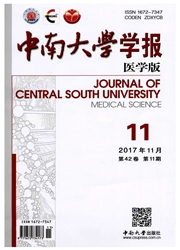

 中文摘要:
中文摘要:
目的:分析偏侧咀嚼患者在最大张闭口运动中的下颌运动特性。方法:采用整群抽样的方法对皖南医学院口腔医学专业2011-2012级在校本科学生进行偏侧咀嚼的口腔流行病学调查,偏侧咀嚼者30名,双侧咀嚼者30名。通过下颌运动轨迹描记(electrognathography,EGN)和咀嚼肌表面肌电图(electromyogram,EMG)同步检测技术,比较偏侧咀嚼和双侧咀嚼人群在大开口运动中的运动轨迹和肌电情况;并进行相关统计学分析。结果:偏侧咀嚼组左二腹肌前腹(left anterior digastric muscle,LDA)、右二腹肌前腹(right anterior digastric muscle,RDA)平均肌电峰值(the average electromyogram peak,Amp)低于双侧咀嚼组(P〈0.05)。偏侧咀嚼组在大张口运动时开闭口轨迹多数分离,开口型与与双侧咀嚼组相比差异有统计学意义(P〈0.05)。偏侧咀嚼组张闭口运动时垂直向和矢状向位移明显低于双侧咀嚼组(P〈0.01)。咬肌Amp与右侧方位移呈正相关。结论:最大张口运动中偏侧咀嚼组LDA,RDA,左咬肌的Amp降低;开口型多数偏向工作侧,50%的人群开闭口轨迹分离,开口度减小;偏侧咀嚼导致肌肉性能改变的同时引起运动轨迹的异常。
 英文摘要:
英文摘要:
Objective: To analyze characteristics of mandibular movement in patients with unilateral mastication. Methods: Undergraduate students in oral medicine from Grade 2011 and 2012 in Wannan Medical College were enrolled for this study by cluster sampling method, which include 30 people with unilateral mastication and 30 people with bilateral mastication. The surface electromyogram (sEMG) of masseter muscle and anterovent of digastric muscle were recorded and the trajectory of mandibular incisor point was recorded simultaneously in the maximum opening and closing movement. The results were analyzed by SPSS 19.0 software. Results: Average electrical peak of left anterior digastric muscle and right anterior digastric muscle in the unilateral chewing group was lower than that in the bilateral chewing group (P〈0.05). The jaw tangent point trajectory was separate in the unilateral chewing group. There were significant differences at the opening type between the 2 groups. The vertical displacement and the sagittal displacement in the unilateral chewing group were significantly lower than those in the bilateral chewing group (P〈0.01). There was significant positive correlation between the average peak potential of masseter muscle and displacement on the right side. Conclusion: Average electrical peak of left masseter muscle, left anterior digastric muscle, and right anterior digastric muscle decreases in the unilateral chewing group. Jaw tracking in most people deflects to the working side. Opening and closing jaw tracking is separate in 50% unilateral chewing individuals with the decreased opening degree. Unilateral chewing leads to changes in muscle performance accompanied by trajectory anomalies.
 同期刊论文项目
同期刊论文项目
 同项目期刊论文
同项目期刊论文
 期刊信息
期刊信息
